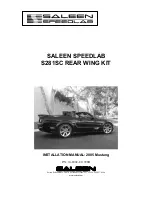
#
Reach into the gap, push lever
2
of the bon-
net catch to the left and lift the bonnet.
When the bonnet has opened around 40 cm, it
will be automatically opened and held by the
gas pressure spring dampers.
Closing the bonnet
*
NOTE Damage to the bonnet due to press-
ing it closed manually
Pushing the bonnet closed with your hands
could damage it.
#
To close the bonnet, let it drop from the
specified height.
#
Lower the bonnet and let it fall from a height of
approximately 30 cm, applying a little force as
you let it go.
#
If the bonnet remains slightly open, open it
again and let it fall, applying slightly more force
as you let it go, until it engages.
Checking/topping up the coolant
&
WARNING Risk of fire‑ and injury from
antifreeze
If antifreeze comes into contact with hot com-
ponent parts in the engine compartment, it
may ignite.
#
Allow the drive system to cool down
before you top up the antifreeze.
#
Make sure that no antifreeze spills out
next to the filler opening.
#
Thoroughly clean the antifreeze from
component parts before starting the
vehicle.
&
WARNING Risk of scalding from hot cool-
ant
If you open the cap when the drive system is at
normal operating temperature, you could be
scalded.
#
Let the drive system cool down before
opening the cap.
#
When opening the cap, wear protective
gloves and safety glasses.
#
Open the cap slowly to release pressure.
Check and top up the coolant only when the vehi-
cle is stationary and in a horizontal position and
the drive system has cooled down. The coolant
temperature must be below 50°C.
&
WARNING Risk of burns from hot compo-
nents in the engine compartment
Certain components in the engine compart-
ment can be very hot, e.g. the drive system
and the cooler.
#
Allow the drive system to cool down and
touch only the components described
below.
Coolant contains glycol and is therefore poison-
ous.
#
Observe the information under "Operating flu-
ids and capacities" (
/
page 250).
*
NOTE Paintwork damage due to coolant
If coolant gets on painted surfaces, the paint-
work can be damaged.
#
Add coolant carefully.
#
Remove spilled coolant.
Regularly check the drive cooling system and the
heating system for leaks. If there is a loss of cool-
ant, have the cause determined and rectified in a
qualified specialist workshop without delay.
Example: cap and coolant expansion reservoir
Checking the coolant level
The vehicle is equipped with two coolant expan-
sion reservoirs.
#
Slowly turn the cap
1
of the coolant expan-
sion reservoir
2
half a turn anti-clockwise and
allow overpressure to escape.
#
Turn cap
1
further and remove it.
Maintenance and care 217
T447 0414 02
Содержание EQV 2021
Страница 1: ...EQV Owner s Manual T447 0414 02 ...
Страница 7: ...T447 0414 02 ...
















































